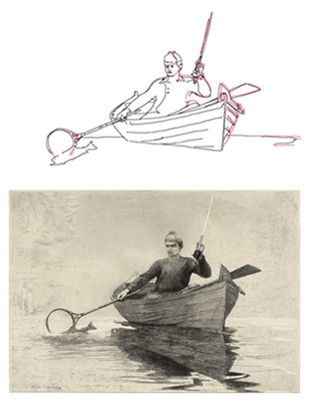Diagram: Design transfer from watercolor to etching
Comparing the monochromatic watercolor Netting the Fish to the etching Fly Fishing, Saranac Lake reveals that Homer transferred the linear design of the figure and boat from the watercolor to a copper plate. Placing tracing paper over Netting the Fish, Homer outlined the main elements with a soft graphite pencil that would not damage the work’s surface. Then he turned the tracing over and centered it face down onto the copper plate in order to transfer the image in reverse. To do this, Homer could have used any number of processes involving copy paper; he may also have transferred the graphite directly to the plate by rubbing it with a hard, smooth implement. Then using the etching needle, Homer once again retraced his transferred lines, carving into the hard ground. A diagram shows the direct correspondence between the watercolor and etching. Aside from the position of the fisherman’s raised knee, deviations from the watercolor to the etching are between one to four millimeters, an understandable deviation given the extensive tracing and retracing involved in the transfer process.
Diagram showing the direct correspondence between Netting the Fish and Fly Fishing, Saranac Lake, indicating that a tracing process was used to transfer the design from the watercolor to the etching plate. The red lines marking the watercolor design show negligible deviations from that of the etching, which is marked in green.

